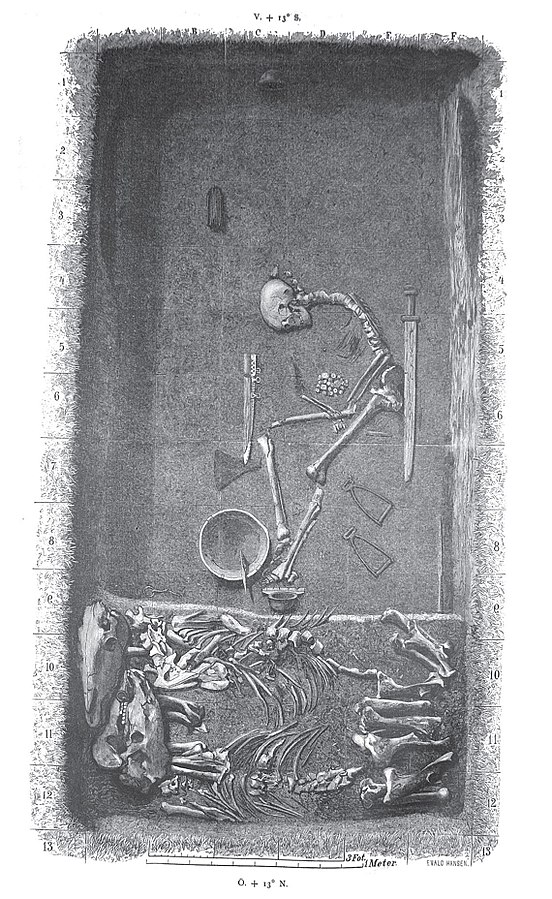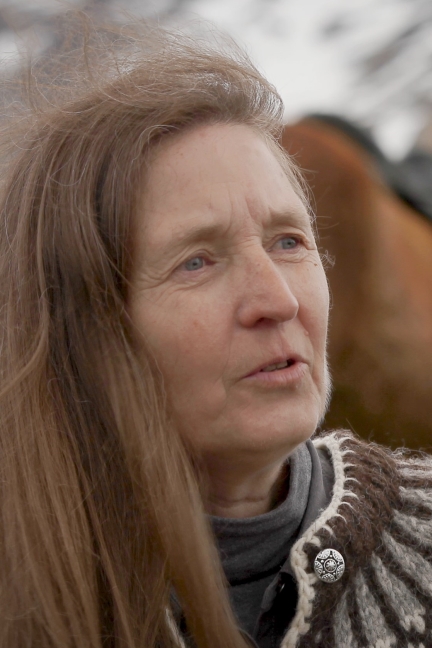by Nancy Marie Brown
When I began writing The Real Valkyrie, I thought it was going to be a book about bones. It turned out to be a book about bias.

This image is in the public domain via Wikicommons.
That’s the problem with thinking of archaeology as a science. Nobody can repeat the experiment.
The Viking burial at the heart of my book, known as Birka grave 581 or Bj581, was excavated in 1878. It is one of 1100 graves dug up near the Viking town of Birka in Sweden in the late 1800s.
Other than one faded drawing, and a few notes, all we have left of this burial are boxes of bones and artifacts with the number “581” inked on them. Anything you read or see about Bj581, or the Birka warrior woman—is an interpretation.
Including the gender of the burial.
There are several ways to sex a burial. The classical one is by the bones. Archaeologists are taught that a woman’s skull is smoother and more rounded than a man’s. Her long bones are more slender. Her pelvis is shaped differently than a man’s.
But there’s no absolute scientific scale for “smoother, rounder, and more slender”—or even for pelvic structure, as I learned by reading the groundbreaking Ph.D. thesis of Ing-Marie Back Danielsson, done at Stockholm University in 2007.
Plus, few Viking skeletons are in good shape. After 1000 years in the soil, the bones are degraded, or missing. In cremation burials, the bones were burned, then crushed. Yet archaeologists still sex these graves. How?
The most common method in the past is what Back Danielsson calls “sexing by metal”: Jewelry for women (especially the oval brooches that hold up the straps of an apron dress). And weapons for men.
It sounds logical. Surely it’s based on statistics, right?
It’s not. The practice began in 1837, before archaeology as a science even existed. It reflects the values of Victorian society, when women were confined to the home and told to concern themselves only with children, church, and kitchen.
If all Viking Age graves with weapons in them are labeled “male,” people assume only men were Viking warriors.
By accepting this Victorian stereotype that only men were warriors, we legitimize the idea that women should stay at home. We reduce the role models for every modern girl who visits a museum or reads a history book.
We make it hard to even imagine a Viking warrior woman like the one buried in Birka grave Bj581.

Photo of Valkyrie from Hårby. Dated Viking age and identified as armed Valkyrie. Displayed at National Museum of Denmark.
This file is licensed under the Creative Commons Attribution-Share Alike 4.0 International license.
This Victorian bias in Viking Studies is why some scholars have found it hard to accept the conclusion reached by the most modern way of sexing a Viking burial—DNA testing.
In 2017, DNA testing revealed that Bj581 was female.
There is no jewelry in this grave, only weapons—and there are more weapons here than in almost every other Viking grave in the world.
For years, Bj581 has been the textbook example of the ultimate Viking warrior’s grave. How could the ultimate Viking warrior be a woman?
The researchers in the DNA study were led by Neil Price of Uppsala University, who is head of a big interdisciplinary project called “The Viking Phenomenon,” and Charlotte Hedenstierna-Jonson of the Swedish History Museum in Stockholm, who wrote her Ph.D. dissertation on the excavation of Birka’s fortress and has defined the “Birka Warrior.”
They called their paper “A Female Viking Warrior Confirmed by Genomics” to recognize the fact that the bones in Bj581 were twice identified by bone specialists as characteristically female—but because of the Victorian bias in Viking Studies, no one would believe it that the ultimate Viking warrior could be a woman.
Their 2017 paper received so many negative comments that they published an expanded paper in 2019: “Viking Warrior Women? Reassessing Birka chamber grave Bj581.”
No, they explained, they did not test the wrong bones. No, they didn’t think two people had originally been buried in the grave—and the male warrior had disappeared without leaving a trace. No, they didn’t think we could tell from the combination of female bones and “male” weapons that Bj581 was transgender or not “socially female”—or not really a warrior at all.
Since it was first opened in the late 1800s, Bj581 has always been interpreted as the grave of a Viking warrior. “We strongly followed the same military reading,” Price and his colleagues conclude, “and for the same sensible reasons…. In doing so, we find no problem in adjusting for the new sex determination.” If Bj581 cannot be called a warrior’s grave, then neither can any other Viking burial with weapons.
Nancy Marie Brown is the author of highly praised books of nonfiction, including Song of the Vikings and Ivory Vikings. They have been favorably reviewed in The New Yorker, The New York Times, The Economist, The Times Literary Supplement, The Wall Street Journal, and many other publications. Brown has spent decades studying Icelandic literature and culture. She lives on a farm in Vermont where she keeps four Icelandic horses and an Icelandic sheepdog.

